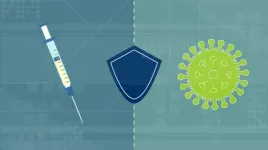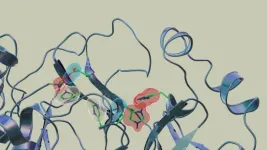Light pollution drives increased risk of West Nile virus
2021-03-24
(Press-News.org) Florida has experienced a relatively mild winter, which typically translates to more mosquitoes in the summer and more birds on which they can feast. If history repeats itself, it's likely there will be an uptick in West Nile virus cases this year, especially in the outer fringes of the suburbs where much of the nighttime illumination emanates from the skyglow of nearby cities.
A new study from the University of South Florida (USF) is the first to provide direct evidence that light pollution is driving infectious disease patterns in nature. The research team previously determined mosquitoes and birds are attracted to light, greatly enhancing the likelihood that they'll spread West Nile virus to animals and humans. Their new findings published in the Proceedings of the Royal Society B are in contrast to previous studies that have blamed urbanization due to its human population density and breeding hotspots, such as drainage systems.
"We knew that light pollution could affect host immune defenses and behavior," said lead author Meredith Kernbach, doctoral student in the USF College of Public Health. "But what we didn't know until now is that light pollution can significantly affect when and where West Nile virus emerges in nature."
The research team, which includes collaborators from the University of Georgia and California Polytechnic State University, modeled West Nile virus exposure data from the Florida Department of Health. They studied 6,468 antibody samples from sentinel chickens collected between the months of June and December over four years in 105 coop locations throughout the state. Researchers found most cases of West Nile virus were present in chickens exposed to low levels of light compared to those surrounded by unpolluted and intensely light-polluted areas.
"We think that we got a peak at low levels of light because of the many ways that light pollution is probably driving risk of infection," said Marty Martin, professor of disease ecology in the USF Center for Global Health and Infectious Disease Research. "Based on prior work, we know that light pollution affects bird immune responses to West Nile virus, but there's probably an effect, too, on mosquito abundance, as most insects are attracted to light. Even birds might be attracted to light-polluted sites, as food could be more plentiful or obvious there. Maybe all of these forces coming together is what elevates risk in modestly light-polluted sites."
Many county health departments use sentinel chickens as a surveillance mechanism to monitor for West Nile virus and other mosquito-borne diseases. They typically don't get sick from the virus and can't transmit it to mosquitoes, people or other birds. Counties strategically place coops in locations that best represent the local human population, helping identify where to direct mitigation efforts that can prevent the spread of infection.
These findings support a 2019 study from USF that found exposure to artificial light increases the infection period of wild birds, increasing the potential of West Nile virus outbreaks by 41 percent.
INFORMATION:
[Attachments] See images for this press release:

ELSE PRESS RELEASES FROM THIS DATE:
2021-03-24
The first personalised advice on the most effective exercise to lower blood pressure is published today in the European Journal of Preventive Cardiology, a journal of the European Society of Cardiology (ESC).1 The ESC consensus document recommends specific activities according to an individual's current blood pressure level.
One in four heart attacks are caused by high blood pressure. It is estimated that by 2025, around 60% of the world's population will have hypertension. While it is widely accepted that exercise lowers blood pressure, until now recommendations have focused on the amount of exercise per week, without considering an individual's starting blood ...
2021-03-24
New research led by the University of Bristol has revealed that crocodiles once flourished on land and in the oceans as a result of fast evolution.
Modern crocodiles are predators living in rivers, lakes and wetlands, grabbing fish, reptiles, birds and mammals with their conspicuous snouts and powerful jaws.
However, new research published today in the journal Proceedings of the Royal Society B, shows that ancient crocodiles were once much more varied because of rapid evolution.
In the time of the dinosaurs, some crocodiles experimented with dolphin-like adaptations to living in the oceans, and others lived on land as fast-moving plant-eaters.
The researchers studied over 200 skulls and jaws, including ...
2021-03-24
SINGAPORE, 23 March 2021 - Scientists from Duke-NUS Medical School, the National Centre for Infectious Diseases (NCID) and the Agency for Science, Technology and Research (A*STAR) Infectious Diseases Labs found that antibodies against SARS-CoV-2 wane at different rates, lasting for mere days in some individuals, while remaining present in others for decades. The study, published in The Lancet Microbe, shows that the severity of the infection could be a deciding factor in having longer-lasting antibodies. Individuals with low levels of neutralising ...
2021-03-24
A University of Birmingham-led study of top-flight UK rugby players - carried out in collaboration with the Rugby Football Union (RFU), Premiership Rugby, and Marker Diagnostics - has identified a method of accurately diagnosing concussion using saliva, paving the way for the first non-invasive clinical test for concussion for use in sport and other settings.
Following the team's previous research, which identified that the concentration of specific molecules in saliva changes rapidly after a traumatic brain injury, the researchers embarked on a three-year study in elite rugby to establish if these 'biomarkers' could be used as a diagnostic test ...
2021-03-24
Potentially paves way for non-invasive diagnostic test at all levels of participation
On a par with the assessment currently provided in professional sports
Could work alongside 'gold standard' head injury protocol used in elite sports
Distinct chemical 'signatures' for concussion have been identified in the spit of elite male rugby players, reveals research published online in the British Journal of Sports Medicine.
This potentially paves the way for a non-invasive and rapid diagnostic test for the condition that could be used pitch side and after the game at all levels of participation, suggest the researchers.
This is especially important because ...
2021-03-23
Scientists at the U.S. Department of Energy's Ames Laboratory have observed novel helical magnetic ordering in the topological compound EuIn2As2 which supports exotic electrical conduction tunable by a magnetic field. The discovery has significant implications for basic research into functional topological properties and may one day find use in a number of advanced technology applications.
Topological materials burst onto the scene in the physical sciences about fifteen years ago, decades after their existence had been theorized. Called 'topological' because their bulk electronic bands are "knotted" together, the surfaces of topological insulators "untie the knot" and become metallic. Researchers ...
2021-03-23
People who received a flu shot last flu season were significantly less likely to test positive for a COVID-19 infection when the pandemic hit, according to a new study. And those who did test positive for COVID-19 had fewer complications if they received their flu shot.
These new findings mean senior author Marion Hofmann Bowman, M.D., is continuing to recommend the flu shot to her patients even as the flu season may be winding down.
"It's particularly relevant for vaccine hesitance, and maybe taking the flu shot this year can ease some angst about the new COVID-19 vaccine," says Hofmann, an associate professor of internal medicine and a cardiologist at the Michigan ...
2021-03-23
While COVID-19 cases may be on the decline, the virus is still prevalent nationwide, and higher education institutions need to prepare for a successful 2021 academic year. New research from Clemson University in The Lancet Child & Adolescent Health, one of the world's premier peer-reviewed general medical journals, indicates how surveillance-based informative testing (SBIT) mitigates the spread of COVID-19 on campus, paving the way for other institutions, even those without the infrastructure or funding for mass-scale testing.
SBIT was implemented during the first two weeks of the Fall semester at Clemson. According to the study, ...
2021-03-23
Another step towards understanding Alzheimer's disease has been taken at the Maisonneuve-Rosemont Hospital Research Centre. Molecular biologist Gilbert Bernier, and professor of neurosciences at Université de Montréal, has discovered a new function for the BMI1 gene, which is known to inhibit brain aging. The results of his work have just been published in Nature Communications.
In his laboratory, Bernier was able to establish that BMI1 was required to prevent the DNA of neurons from disorganizing in a particular way called G4 structures. This phenomenon occurs in the brains of people with Alzheimer's disease, but not in healthy elderly ...
2021-03-23
Scientists have found new, unexpected behaviors when SARS-CoV-2 - the virus that causes COVID-19 - encounters drugs known as inhibitors, which bind to certain components of the virus and block its ability to reproduce.
Published in the Journal of Medicinal Chemistry, the research provides key insights for advancing drug design and drug repurposing efforts to treat COVID-19.
Researchers at the Department of Energy's Oak Ridge National Laboratory used neutron scattering to investigate interactions between telaprevir, a drug used to treat hepatitis C viral infection, and the SARS-CoV-2 main protease, the enzyme responsible for enabling the virus to reproduce.
They ...
LAST 30 PRESS RELEASES:
[Press-News.org] Light pollution drives increased risk of West Nile virus



